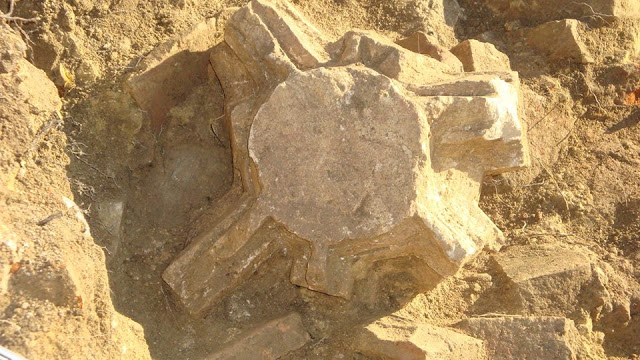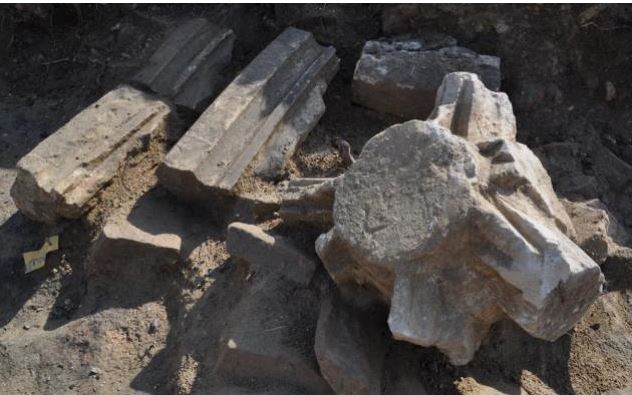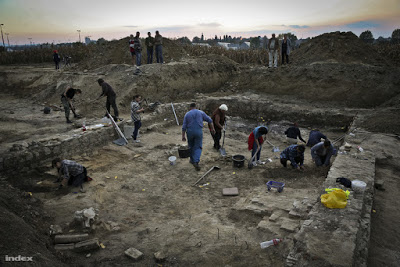Medieval History



- Archaeologists Discover Church Remains In Turkish Ancient City
Archeologists have unearthed remains of a church in an ancient city in the Mediterranean province of Isparta, head of the team said on Monday. Associate Professor Mehmet Ozhanli, the head of Suleyman Demirel University's Archeology Department who...
- Exhibition About The Matthias Church
A major new exhibition about the building and the history of the Church of Our Lady (Matthias Church) of Buda Castle opened at the Budapest History Museum. The Church is a major historic monument of Budapest, part of the Unesco World Heritage site of...
- 800 Years Of Ják Abbey
Fresco of St. George at Ják, c. 1256 This weekend - the weekend after Saint George's Day - mark the 800th anniversary of the foundation of the Benedictine monastery of Ják. It is known that the monastery was established by Márton "the Great"...
- Remains Of Carolingian Palace Found At Zalavár
The church of St. Hadrianus at Mosaburg/Zalavár (from Wikipedia) The area of Zalavár in western Hungary has long been one of the most interesting archaeological sites of medieval Hungary, especially for the Carolingian period. The area has been idetified...
- Earliest Christian Church Of Transylvania Found At Gyulafehérvár
Traces of the oldest church of TransylvaniaPhoto from www.kronika.ro New archaeological research near the Roman Catholic Cathedral of Gyulafehérvár (Alba Iulia, Romania, the seat of the bishopric of Transylvania) led to the discovery of the...
Medieval History
The lost medieval church of Bonyhád
It is rare that the excavation of a simple medieval parish church makes national news in Hungary. However, this is precisely what is happening these days with the remains of the medieval church of Bonyhád in southern Transdanubia: largely because there seems to be no time and no way to fully excavate and preserve the ruins. This is because of recent changes in Hungarian heritage laws, which favor construction and development instead of heritage protection.

The remains of the church of Bonyhád were discovered during the construction of a new exit from route 6. Current legislation only gives 30 days for any archaeological investigations in such situations, with a possibility of further extension granted by the Ministry of Culture. This extension has to be given by the Minister himself within 8 days - if he does not grant it, construction can continue without delay. The remains of the church of Bonyhád were discovered in late September. Thanks to the cooperation of a team of Hungarian archaeologists, the excavation was carried out during the last two weeks - but now work is coming to an end, as the construction of the road will commence on Wednesday.
 |
| Photo: István Huszti / Index |
So let's see what was found: excavations have brought to light the nave of a medieval church (the sanctuary lies under the main road built a long time ago). It seems that the edifice was the medieval parish church of Bonyhád, which in the Middle Ages was located at some distance from the current center of the settlement. The church must have been destroyed in 1542 when the Ottoman Turkish army pushed through this area. The church burnt down, its walls were torn down some time later, and the site was abandoned. The site soon filled up with mud - thus the remains were preserved in good condition. A keystone and other fragments of the late Gothic vault of the church were found, along with the remains of the bell, as well as stone carvings from the portal of the church and other structural elements. Here are some photos of the stone carvings:
The excavation was one of the first times when the new heritage laws of Hungary were applied in a real-life scenario, and it became obvious that the regulations are not sufficient to protect archaeological heritage. Despite protests from the Association of Hungarian Archaeologists and even a statement by the ombudsman, it seems that the site will have to covered over before the excavations can fully be completed, as construction will resume as early as next week. Maybe the ensuing debate and national attention will help lawmakers rethink the current regulations.
Photos: Facebook - Save the Gothic church of Bonyhád! group
 |
| Photo: István Huszti / Index |
- Archaeologists Discover Church Remains In Turkish Ancient City
Archeologists have unearthed remains of a church in an ancient city in the Mediterranean province of Isparta, head of the team said on Monday. Associate Professor Mehmet Ozhanli, the head of Suleyman Demirel University's Archeology Department who...
- Exhibition About The Matthias Church
A major new exhibition about the building and the history of the Church of Our Lady (Matthias Church) of Buda Castle opened at the Budapest History Museum. The Church is a major historic monument of Budapest, part of the Unesco World Heritage site of...
- 800 Years Of Ják Abbey
Fresco of St. George at Ják, c. 1256 This weekend - the weekend after Saint George's Day - mark the 800th anniversary of the foundation of the Benedictine monastery of Ják. It is known that the monastery was established by Márton "the Great"...
- Remains Of Carolingian Palace Found At Zalavár
The church of St. Hadrianus at Mosaburg/Zalavár (from Wikipedia) The area of Zalavár in western Hungary has long been one of the most interesting archaeological sites of medieval Hungary, especially for the Carolingian period. The area has been idetified...
- Earliest Christian Church Of Transylvania Found At Gyulafehérvár
Traces of the oldest church of TransylvaniaPhoto from www.kronika.ro New archaeological research near the Roman Catholic Cathedral of Gyulafehérvár (Alba Iulia, Romania, the seat of the bishopric of Transylvania) led to the discovery of the...
